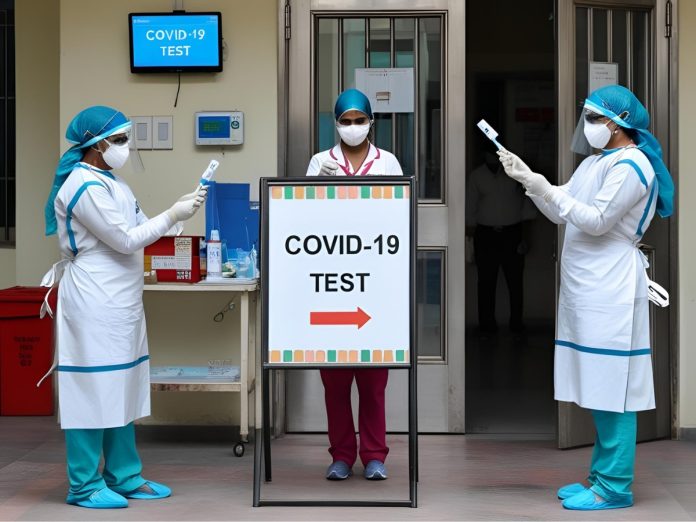As of May 25, 2025, India is experiencing a mild but noteworthy increase in corona cases. After months of steady control, this uptick has sparked renewed attention from public health authorities and medical experts. Though far from alarming, the rise in infections reminds us that the COVID-19 virus is still present and evolving. Several states have started reporting a spike in cases, primarily mild in nature, with the majority managed through home isolation and basic care protocols.
The latest corona news suggests that Kerala remains the most affected region, with an estimated 273 active cases. Health officials confirm that symptoms in these cases are generally mild, involving fever, cough, fatigue, and other flu-like signs. Tamil Nadu is also experiencing an increase, where the country’s first confirmed case of the new NB.1.8.1 variant was detected. Maharashtra has reported 56 active cases, including a few deaths among individuals with underlying health conditions. Meanwhile, Delhi has registered 23 new corona cases in India today, sparking localized testing and monitoring efforts.
The Union Health Ministry has emphasized that the overall positivity rate remains below 1% nationwide. Most patients are recovering without the need for hospitalization, and healthcare systems are not experiencing any significant burden. However, the emergence of new variants like NB.1.8.1 and LF.7 is prompting increased genomic surveillance. While these variants are under the World Health Organization’s “Variants Under Monitoring” category, they have not yet shown signs of heightened severity or transmissibility.
Delhi’s health authorities have reassured the public that the recent rise in corona cases does not suggest the start of a new wave. Instead, they attribute the spike to post-seasonal flu trends and minor viral activity. Testing centers have been alerted, and contract tracing is being actively conducted in affected zones. Public health officers have stressed that all the reported symptoms are mild and no hospital overload has occurred.
In Karnataka, the number of active cases fluctuates between 13 and 35. Bengaluru and nearby districts have reported isolated infections, including among children. None of the cases have resulted in severe outcomes, but precautionary testing in schools and public places is being encouraged. Gujarat, on the other hand, has confirmed four cases of the LF.7 variant, with investigations ongoing to trace the origin of infection.
he majority of new cases are being reported from a few specific regions, most notably the southern state of Kerala. With around 273 active cases, Kerala has emerged as the most affected region in this fresh uptick, though state health authorities confirm that hospitalization remains extremely rare. Tamil Nadu follows with 66 active cases, where the first confirmed case of the new NB.1.8.1 variant has been detected. This variant, currently under global monitoring, has not shown any signs of increased severity but is being studied closely. Maharashtra, another state that has seen its fair share of COVID-19 waves in the past, has also reported a rise in cases—56 as of this week. A few recent deaths linked to COVID-19 in Maharashtra have reportedly involved elderly patients with pre-existing health conditions, reminding citizens of the continued threat the virus poses to vulnerable populations.
In the national capital, Delhi, 23 new cases have been recorded over the past ten days. Though the numbers are low, authorities are taking the situation seriously. Investigations are underway to determine whether these infections are imported or indicate a potential local transmission. Officials emphasize that the symptoms observed so far resemble those of the seasonal flu—runny noses, headaches, sore throats, fatigue—and no unusual patterns of illness or hospitalization have been reported. Nevertheless, residents are being advised to practice standard precautions, including mask usage in crowded indoor spaces and regular hand hygiene.
Authorities have advised the public to continue following standard health practices. These include wearing masks in crowded or poorly ventilated areas, washing hands regularly, and avoiding large gatherings if symptomatic. The Health Ministry has emphasized that vaccinations remain a critical component in curbing the virus. Booster doses are available across most government and private healthcare facilities. A new booster tailored to the JN.1 variant is expected to launch by July 2025.
Despite the increase in corona cases in India today, India’s healthcare system is fully equipped to handle any rise in cases. The government’s commitment to genomic sequencing, public awareness, and mass vaccination has kept hospitalization rates extremely low. Experts say that while the situation does not warrant panic, it certainly calls for sustained caution and community-level responsibility.
Despite the presence of these new variants, health experts maintain that there is no cause for widespread concern. India’s healthcare infrastructure, including testing labs and genomic surveillance centers, remains well-equipped to detect and respond to any future surge. The overall positivity rate across the country is below 1%, and the need for oxygen support or ICU admissions is practically nonexistent in this wave. Most patients are recovering within five to seven days with mild symptoms and without requiring hospitalization.
The Delhi government, reacting to the new developments, has reiterated that the situation remains under control. A senior health official explained that most recent cases were discovered through routine testing or reports of flu-like symptoms in local clinics, and there is no evidence so far to suggest that the virus is spreading rapidly. Still, contact tracing has been initiated in all reported cases, and the health department continues to monitor new symptoms and mutation patterns closely.
Globally, the World Health Organization has acknowledged the rise in infections and new variants in countries like India, but maintains that these variants are currently not a significant threat. WHO encourages transparent data sharing and emphasizes the importance of public vigilance.
To conclude, the slight resurgence in corona cases across India is being met with preparedness and precaution rather than panic. The public is advised to stay alert, follow health guidelines, and get vaccinated if eligible. While the virus continues to evolve, India’s response system appears stronger than ever. For the latest and most accurate corona news, stay tuned to TalesXP.
This article is part of our ongoing COVID-19 coverage. Stay connected with TalesXP for timely updates, verified data































